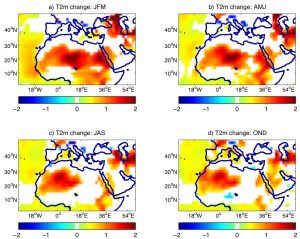l’article du mois – septembre 2013
 Recent changes in air temperature, heat waves occurrences, and atmospheric circulation in Northern Africa
Recent changes in air temperature, heat waves occurrences, and atmospheric circulation in Northern Africa
par B. Fontaine, S. Janicot, et P.A. Monnerie
JOURNAL OF GEOPHYSICAL RESEARCH: ATMOSPHERES, VOL. 118, 8536–8552, doi:10.1002/jgrd.50667, 2013
This study documents the time evolution of air temperature and heat waves occurrences
over Northern Africa for the period 1979–2011. A significant warming (1°–3°C), appearing
by the mid-1960s over Sahara and Sahel, is associated with higher/lesser frequency of warm/
cold temperatures, as with longer duration and higher occurrences of heat waves. Heat waves
episodes of at least 4 day duration have been examined after removing the long-term
evolution. These episodes are associated with specific anomalies: (i) in spring, positive
low-level temperature anomalies over the Sahel and Sahara; low and midlevel cyclonic
rotation over Morocco associated with a Rossby wave pattern, lessening the Harmattan;
more/less atmospheric moisture westward/eastward to 0°; upward/downward anomalies
above the western/eastern regions associated with the Rossby wave pattern; (ii) in
summer, a similar but weaker positive low-level temperature anomaly (up to 3°C); less
moisture westward to 10°W, a cyclonic anomaly in central Sahel favoring the monsoon
eastward to 0° and a midlevel anticyclonic anomaly over the Western Sahara, increasing
southward the flux divergence associated with the African Easterly Jet. In March–May,
two to three heat waves propagate eastward. They are preceded by an abnormal warm cell
over Libya and southwesterlies over the West Sahara. A large trough stands over North
Atlantic while midtropospheric subsidence and anticyclonic rotation reinforce over the
continent, then migrates toward the Arabian peninsula in breaking up. These signals are
spatially coherent and might suggest the role of short Rossby waves with an eastward
group velocity and a baroclinic mode, possibly associated with jet stream deformation.
Citation: Fontaine, B., S. Janicot, and P.-A. Monerie (2013), Recent changes in air temperature, heat waves occurrences,
and atmospheric circulation in Northern Africa, J. Geophys. Res. Atmos., 118, 8536–8552, doi:10.1002/jgrd.50667.
- extrait:
- lien_externe:
- kc_data:
- a:8:{i:0;s:0:"";s:4:"mode";s:0:"";s:3:"css";s:0:"";s:9:"max_width";s:0:"";s:7:"classes";s:0:"";s:9:"thumbnail";s:0:"";s:9:"collapsed";s:0:"";s:9:"optimized";s:0:"";}
- kc_raw_content:
 Recent changes in air temperature, heat waves occurrences, and atmospheric circulation in Northern Africa
Recent changes in air temperature, heat waves occurrences, and atmospheric circulation in Northern Africapar B. Fontaine, S. Janicot, et P.A. Monnerie
JOURNAL OF GEOPHYSICAL RESEARCH: ATMOSPHERES, VOL. 118, 8536–8552, doi:10.1002/jgrd.50667, 2013
This study documents the time evolution of air temperature and heat waves occurrences
over Northern Africa for the period 1979–2011. A significant warming (1°–3°C), appearing
by the mid-1960s over Sahara and Sahel, is associated with higher/lesser frequency of warm/
cold temperatures, as with longer duration and higher occurrences of heat waves. Heat waves
episodes of at least 4 day duration have been examined after removing the long-term
evolution. These episodes are associated with specific anomalies: (i) in spring, positive
low-level temperature anomalies over the Sahel and Sahara; low and midlevel cyclonic
rotation over Morocco associated with a Rossby wave pattern, lessening the Harmattan;
more/less atmospheric moisture westward/eastward to 0°; upward/downward anomalies
above the western/eastern regions associated with the Rossby wave pattern; (ii) in
summer, a similar but weaker positive low-level temperature anomaly (up to 3°C); less
moisture westward to 10°W, a cyclonic anomaly in central Sahel favoring the monsoon
eastward to 0° and a midlevel anticyclonic anomaly over the Western Sahara, increasing
southward the flux divergence associated with the African Easterly Jet. In March–May,
two to three heat waves propagate eastward. They are preceded by an abnormal warm cell
over Libya and southwesterlies over the West Sahara. A large trough stands over North
Atlantic while midtropospheric subsidence and anticyclonic rotation reinforce over the
continent, then migrates toward the Arabian peninsula in breaking up. These signals are
spatially coherent and might suggest the role of short Rossby waves with an eastward
group velocity and a baroclinic mode, possibly associated with jet stream deformation.
Citation: Fontaine, B., S. Janicot, and P.-A. Monerie (2013), Recent changes in air temperature, heat waves occurrences,
and atmospheric circulation in Northern Africa, J. Geophys. Res. Atmos., 118, 8536–8552, doi:10.1002/jgrd.50667.
